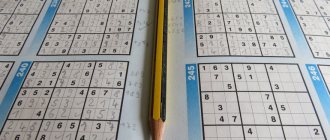Listen to the audio version of this article on our podcast:
First, let's define what it actually is.
Like normal fatigue, mental fatigue
(also known as psychological fatigue or mental fatigue) is a condition that results from intense or prolonged work. The only difference is that here the brain gets tired, not the body. Such fatigue is accompanied by a feeling that the brain cannot function properly, that it seems to be covered in fog. Because of this, even simple tasks begin to eat up a lot of time.
Remember how, at the end of a hard working day, you reread the same paragraph over and over again, unable to understand what is even written there. This is what it is.
Mental fatigue can be acute or chronic. An acute one occurs, for example, at the end of the hardest working day and goes away after a short rest. This kind of fatigue is normal. But if ignored, it can become chronic and lead to burnout.
Why does the brain get tired?
All brain functions are regulated by inhibitory and excitatory systems, each of which is responsible for the functioning of its departments. When both systems are in balance, a person is full of strength and energy. If the inhibitory system begins to dominate, mental fatigue appears. Its symptoms are decreased performance, concentration and memory.
In Maxim Dorofeev’s book “Jedi Techniques,” the level of mental energy responsible for brain activity is called “thought fuel”:
“Thought fuel” is a supply of a certain resource necessary for the work of slow thinking (as well as for self-control).”
When the level of “thought fuel” is low, even the simplest tasks are solved slowly. Procrastination and laziness appear, which are actually a consequence of depletion of mental resources.
Other reasons
- Emotional toll
When trying to understand the reasons for the inability to think productively, it is important not to confuse sound problems with problems in other vectors. Thus, one of the reasons for the loss of the ability to think clearly may be an emotional catastrophe in the owner of the visual vector.
This happens when a strong emotional connection is broken, when you break up with a loved one, or in the event of loss. Stress can be so intense that it literally makes life meaningless. If acute stress is not dealt with in a timely manner, then, as a result of dulling of emotions and withdrawal from life, a person feels constant fatigue and a desire to sleep. The head is like an empty bucket.
Love and communication give meaning to life to a visual person. And when this goes away, the taste for life is lost. In the presence of a sound-visual combination of vectors, the visual vector in melancholy and apathy can pull the sound vector with it into negative states, in particular, the sound ability to concentrate also suffers. This applies more to audio-visual women, because men are less likely to confuse love with the meaning of life.
- Resentment
One of the most severe conditions in which life can literally stop. A person in his thoughts is so fixed on the past, on long-gone events, that he is not able to think purposefully. All his desires and thoughts are imperceptibly subordinated to the state of experienced injustice; everything that happens is distorted and perceived through the prism of resentment.
Where is the “thought fuel” lost?
According to a study conducted by David Meyer, Ph.D., of the American Psychological Association, even briefly switching to another task while working on the main one reduces productivity by 40 percent.
Multitasking here means not only solving work issues, but also any other actions.
Scrolling through Instagram feeds or watching funny videos on Youtube are also tasks, and no less mental resources are spent on them than on checking students’ notebooks. Thus, social networks and surfing the Internet cannot be considered as a “reboot” for the brain.
Another reason for mental fatigue is a large number of unfinished tasks. According to the “unfinished business concept,” developed by Soviet psychologist Bluma Zeigarnik, the brain constantly keeps such things and actions in mind (“Zeigarnik effect”) and, as a result, cannot relax, creating constant internal tension.
Habit 1. Spend the morning so that your brain invigorates
We assign a daily routine
It is impossible to maintain a youthful brain if life is extremely monotonous.
However, there is also something that is better not to change at all. This is the daily routine. You need to wake up every morning at about the same time, then spend some time in the sun. Try to do the most important things at the moment of greatest brain activity, and in the evening go to bed as early as possible. If you constantly adhere to approximately this schedule, your brain will work more stable. And this is very important for everyone.
You probably know about jet lag. This is a condition when the brain’s operating mode ceases to coincide with the daily routine. You need to act, but you can’t, because your brain is used to sleeping at this time, and vice versa - you want to go to bed, but you can’t fall asleep.
This is roughly how the brain feels when the daily routine is disrupted. The only way to fix this is to create a starting point in your daily life.
Neglect of daily routine is a direct road to dementia, and this is not an exaggeration.
Making the brain work
If you wake up at a certain time and stand in the sun for a little while, then the brain will somehow also switch into working mode (the human and animal body checks its internal clock with the intensity of sunlight). However, it cannot be said that from that moment the brain fully woke up.
You've probably heard that it begins to work actively only two hours after waking up, and if you are going to take an exam, you need to get up at least two hours before entering the classroom. But if these two hours differ little in activity from sleep, then this will not give the desired results.
Just like the body, the brain needs to warm up. A morning warm-up that includes a load on the primary functions of the brain is a great way to wake up the areas responsible for thinking.
If you wake up every morning shortly before leaving the house, take the subway or train without walking even ten minutes, and spend the entire working day at the computer, then try to wake up early and do a couple of things from this list:
- walking or other light physical activity;
- cleaning the room;
- cooking;
- plant care;
- simple dialogue with someone (greeting, exchanging a couple of remarks);
- reading aloud (if possible, at least 10 minutes).
Chatting or reading aloud
Lately there has been a lot of talk that reading aloud is very useful. This is true, because this process involves not only the eyes and speech apparatus, but also working with information (perception - processing - reproduction). When we read a text silently, some passages may remain unclear, but to read aloud, we need to delve into the content. This is precisely the information processing stage. Pronouncing the text is the stage of its reproduction.
Morning training has a good effect on the speed of visual perception of information, and on hearing, and on the ability to express one’s thoughts without hesitation, including in writing. To give an example from sports, it is similar to simple team exercises.
Constantly reading aloud will be especially useful for those who communicate little with people. When you read the text, it’s better not to just say it, but imagine it as if you were doing it to someone else.
Summary:
- Compliance with the regime is important for stable brain function.
- To do this, you need to create a starting point: always get up at the same time.
- Warm-up is also important for the brain. You need to move and talk.
How to “recharge” your brain
Several practices will help reduce nervous tension, take a break from thinking about current tasks, and restore the level of “mental fuel”.
Creation
Even at the beginning of the last century, handicrafts were used in French hospitals as a way to restore the mental health of soldiers after the First World War. And a study published in the Journal of Positive Psychology found that daily creative activity has a positive effect on mood.
“Doodle” technique for relieving tension
The Doodle technique comes from art therapy. Its author is British psychoanalyst Donald Winnicott. This method is used to relieve tension in children and adults. Due to creative expression and spontaneity of action, the technique relieves emotional and muscular tension, weakens control, and promotes relaxation.
How to practice: Take a sheet of A4-A3 paper, wax crayons or colored pencils. Choose any color, close your eyes and, without thinking, create an abstract drawing. Then you can take another color and continue drawing.
Zentangle technique
Zentangle is a meditative painting technique developed by artist Maria Thomas and her friend Rick Roberts to relieve mental and emotional stress.
How to practice: The drawing is done on thick paper in a square format of 9x9 cm. It is necessary to outline a line-border and shade the square inside in a random order. Next, create patterns in the resulting segments with a black gel pen or marker. The resulting drawings can be colored.
Meditation
According to a study conducted using computed tomography of the brain, people who are constantly in a hurry and multitask, cannot concentrate in the moment, lose touch with reality, and the amygdala (an ancient area of the brain responsible for mobilizing strength in times of danger) constantly is in activity mode.
Meditation will help relax the body and brain - it transfers the nervous system from active mode to energy saving mode.
“It’s easy for modern people to switch their attention, but it’s very difficult to keep it on anything for a long time. In the age of high speeds, gadgets and an abundance of information, it is very important for all of us to develop an internal observer,” says Marina Mineeva, a certified physical education teacher, certified body therapist and movement specialist. — In body therapy, it is believed that all problems begin precisely when we stop listening to the body and turn on the rational mind and common sense. If meditation is considered as an element of yoga, this is a state when a person plunges his senses within himself and maintains continuous one-pointed attention.”
Meditation technique
How to practice: Sit comfortably or lie down. Close your eyes and connect with your “inner observer.” Listen to your body: where is heaviness and tension, and where is lightness and comfort? Don’t try to change anything - just walk with your inner gaze through your “physical home”. After some time, you will begin to feel joy, happiness, love within yourself. Such practices have a cumulative effect and, if performed regularly, will be an excellent contribution to maintaining the health of your body and psyche.
When will the condition return to normal?
Feeling better after complex therapy. It is recommended to follow all healthy lifestyle measures. You need to eat right, walk in the fresh air, and become physically active. Then you may not need long-term use of medications to normalize your well-being.
The decision to take nootropics is made by the doctor; they have side effects and contraindications that the patient may not be aware of.
If the use of nootropics is recommended, it is recommended to undergo a preliminary examination. 1-2 weeks after taking the drug, laboratory blood and urine tests are repeated to eliminate the risk of side effects.
After taking the medications, the condition returns to normal within 1 month. The effect is cumulative. If a person decides to do without drugs, but does exercise therapy, walks, eats the right food, drinks a lot of water, it may take longer. If changes occur in the brain, the fibers are restored gradually. It takes time for nutrients, vitamins, microelements, minerals, and oxygen to reach the brain.
Use other routes
Home – work – home. This route may remain unchanged for years. The result is that the brain goes through it on autopilot, not getting involved in the process at all. Try to get to the office in different ways and thoroughly explore the area where you live, walk where you have not been before. And before traveling to a new place, carefully study the maps in advance and try to get to the desired point without looking at the map application and navigator tips.
Photo: istockphoto.com
Pomodoro method
The method was developed by student Francesco Cirillo; he came up with an interesting name thanks to a timer in the shape of a tomato. To increase productivity and not constantly switch to small tasks, you need to set yourself a rule - work for 25 minutes, rest for 5 minutes. After an hour of work, take a long break for 15-20 minutes. You can adjust the time to suit your needs, for example, set aside 50-60 minutes for tasks, and leave 10 minutes for a break. You can learn more about the Pomodoro technique from our previous article.
Habit 2. Increase concentration
Let's go for a walk after lunch (or have a meeting)
After lunch, blood flows into the stomach area, which makes the brain function worse and makes it more difficult to concentrate and solve non-trivial problems. Surely you have encountered this phenomenon. A short walk helps here.
Minor physical activity like exercise improves not only digestion, but also blood flow to the brain. However, you can simply clean up your desk or hold a small meeting.
We determine the time and volume of work to be done
Try to remember how you passed your exams. You were able to solve so many problems in 90 minutes because you were initially limited by this time. Will it be possible to achieve the same result without a clear time frame? Hardly. If you are constantly distracted and do your work inattentively, it can take the whole day.
Let's say you have 24 hours to complete a project, but you don't know where to start.
Imagine you only have 90 minutes and it will be easier to prioritize. You will immediately begin to think about what is important and what is not so important, and what should not be missed under any circumstances. Moreover, urgent and important work often requires tight deadlines.
When you have little time to complete a task, you may think that you could do a better job with more time. However, if you were not limited, it would be much more difficult to build a workflow, and the task would only become more complicated.
Let's not stop in the flow
Once you have achieved high brain performance, this state continues for some time. This has happened to many: when you urgently need to concentrate and complete one task, the next one is completed faster. You are in a state where you want to do something else or talk to someone, otherwise you won’t calm down.
Using this property of the brain will allow you to do your work efficiently. After warming up the brain, you need to create conditions under which its performance will quickly increase. Then we set a time limit for ourselves and work just that much, this will allow us to concentrate and think faster.
Such intervals of intense labor may last no more than a couple of hours. If you work longer, it will be difficult to control the ratio of the volume of tasks and the time to complete them. And your pressure will almost disappear.
Doing something outside of work
If a person believes that he can sacrifice personal time and finish everything necessary for work at home, he does not experience a period of high brain productivity. When the brain constantly functions ineffectively, attention wanders and people begin to think about extraneous things. I can't finish anything, and it takes more and more time to catch my breath.
This leads to unpleasant consequences. A person wants to take a break from the process of continuous work and gets used to stretching it out over the whole day. He works very slowly and goes to bed later and later. The routine is disrupted and the brain stops functioning normally. When a person falls into such a vicious circle, he needs to immediately set a time limit for himself.
If at 17:00 you need to leave the office, come home and have dinner with the children, and on the weekend it would be nice to meet with friends, then you need to get the work done before five o’clock, right? Then you will be able to distribute your time: for example, some work needs to be completed in the morning, another – before three o’clock. Schedule time is very important.
Pay attention to the work of others
Competition is important to improve brain performance. If it seems to you that the word “competition” is too clearly expressed confrontation, you can simply think differently: “He is trying - and I will too.” The point is that brain performance is relative. A person can achieve much better results when he knows that those around him are superior. It's like sports. If a sprinter runs alone, he will not show excellent results, but if he has a rival, he will be able to run at least a fraction of a second faster. It’s the same in work: if you do it alone, your efficiency doesn’t increase in any way. It is important to act while looking at other people.
Summary:
- Desire alone is not enough to improve concentration and speed of thinking.
- It is necessary to determine the ratio of the amount of work and the time given to complete it.
- It will be more difficult to highlight the most important thing if you do not limit yourself in time.
How do tension headaches manifest?
With tension-type headache, the head hurts on both sides in the temples, back of the head, and crown area. The pain itself is pressing or squeezing in nature, but not pulsating. They rarely become strong and painful. Most often, the pain is mild or moderate in intensity. Patients often describe their sensations as “squeezing the head with a hoop,” “girdle pain around the temples,” “pressing pain, like a helmet or helmet.” They may occur:
- in the morning immediately or shortly after waking up, persist throughout the day, often alternately weakening and gaining intensity;
- in the afternoon, especially after suffering stress, anxiety or performing particularly strenuous work, a long stay in a forced uncomfortable position that provokes overstrain of the muscles of the neck and head (most often when working at a computer, machine tool, driving a car, etc.).
The attack begins gradually, although with serious emotional shock it can develop abruptly. It may be accompanied by:
- decreased appetite;
- deterioration of health when staying in a noisy and crowded room;
- a feeling of pressure in the eyes;
- a feeling of stiffness of the head and movements with it;
- unpleasant sensations when combing hair or wearing a hat;
- sleep disturbance, insomnia due to pain in the head that persists even at night.
But HDN does not completely deprive a person of working capacity, although it has a negative effect on it. Also a characteristic feature of tension headaches is an improvement in the condition when experiencing positive emotions, during pleasant activities, rest, and relaxation. In some cases, even switching attention from one task to another, more pleasant one, leads to a decrease in the severity of pain in the head.
When a headache occurs, some patients notice transient or permanent discomfort, a feeling of tension in the back of the head, the back of the neck and the shoulders. Sometimes the muscles in these areas are so tense that outright pain occurs. This is called “coat hanger” syndrome and is mainly caused by prolonged stay in a static position with a bowed head. The severity of muscle tension increases as the intensity and frequency of headache attacks increases.
Tension headaches differ from migraines in the absence of a sensation of pulsation, the bilaterality of the process, as well as the absence of nausea, vomiting, severe photophobia and intolerance to loud sounds. Although sometimes it is still possible to experience slight increased sensitivity to light and sounds.
Chronic tension headaches are somewhat more severe. Although the attacks occur with the same symptoms, their high frequency exhausts the person. This affects not only his ability to perform daily duties, but also affects his psychological state, causing irritation, increased anxiety, sleep disturbances, melancholy, and depressive disorders. All this together significantly reduces the patient’s quality of life.
TTH needs to be differentiated from headaches due to vegetative-vascular dystonia (VSD). In the latter case, in addition to a headache, patients note dizziness, a feeling of palpitations, increased sweating of the palms, trembling hands, tingling in the chest, difficulty breathing, or only some of these symptoms. With VSD, presyncope or even loss of consciousness is often observed.











